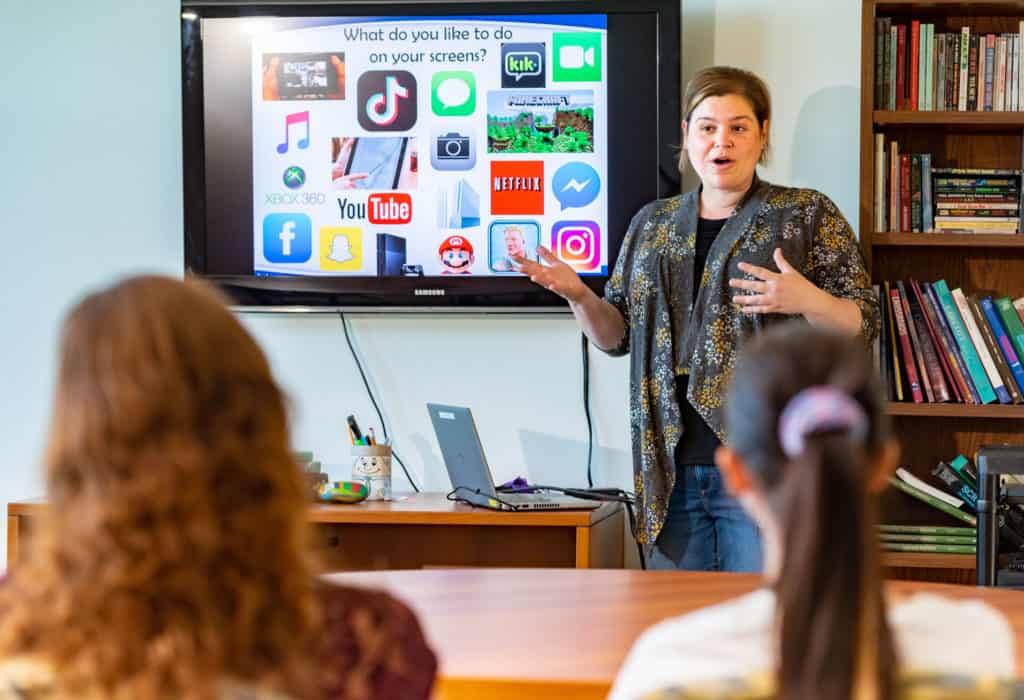By Bonnie Schiedel • Photos by Dan Ventrudo
The phone calls started about six years ago. Worried parents or caregivers would reach out to Ember Schincariol and Karlee Gutmann, mental health professionals in Thunder Bay, Ontario. “They were really concerned about their kids. They were noticing that they were withdrawing from other activities that they really used to enjoy, like sports or music or arts and crafts. Gaming was really taking priority,” says Schincariol, who is a social worker and addictions counsellor at Sister Margaret Smith Centre (SMSC), which runs programs to help people manage addiction and mental health challenges. “They also had concerns around schooling—again, gaming would take priority over homework or studying for tests. And so parents were like, ‘What do we do?’ It was new territory, and they were really unsure how to address it.” Schincariol speculates the uptick in concern was the result of a combination of a growing promotion of the need for “safe gaming,” headed up by experts at institutions like Centre for Addiction and Mental Health, and an increase in games that encourage addictive behaviour and never-ending play. Thunder Bay and the communities that surround it aren’t outliers when it comes to problem gaming, although in a workbook aimed at youth,¹ researchers at the Northern Ontario Gambling Research Hub at Lakehead University in Thunder Bay point out a couple of unique challenges that arise from living in the North: boredom, which results from the perception that there are fewer activities available than in urban centres; and how isolation or concerns around privacy may make it tougher to seek help in small, tight-knit communities.
Of course, digital gaming—computer games, console games, mobile apps—is more than just a lot of fun for people of all ages. Games are an established cultural form that combine art, storytelling and interactivity, many of which are designed to require skill and creativity to play. Some games are educational tools unto themselves: school boards around the world use Minecraft to promote problem-solving and collaboration, and strategy games like Civilization VI can help teachers and parents fan sparks of interest in ancient cultures, history and geography. Recent research from the University of Saskatchewan adds to evidence that gaming can relieve stress and promote mental health and emotional well-being. Many people turned to Animal Crossing: New Horizons—a recently released game centred on working with others to develop virtual communities—to help them cope with the social distancing required during the COVID-19 pandemic in 2020.
Nevertheless, for some young people, gaming can easily slide into unhealthful territory. It is uncommon for kids to be considered “addicted” to gaming, but it can contribute to problem behaviours such as skipping meals or not sleeping enough. Schincariol and Gutmann began meeting with parents and kids to develop ways of putting limits in place. “The reality is that technology isn’t going anywhere. Our role as parents or as helpers is to help people learn how to balance [young people’s] technology use with other activities,” says Schincariol.
Soon, however, Schincariol and Gutmann realized they had an opportunity to talk to kids about their gaming habits before they became a problem. Five years ago, they created an in-class workshop that is aligned with Ontario’s health and physical education curriculum and aimed at students in Grades 4, 5 and 6. This age group of nine- to eleven-year-olds is very reachable, she says, because they are so enthusiastic and willing to share. They paired their flyers with other content for an existing program about substance use, and teachers started booking them for classroom visits.
Sandi Capasso was eager to bring the workshop to her Grade 4 class in Thunder Bay. “[Students] are growing up in a connected world. I think that any knowledge they can get about healthy gaming is important,” she says, adding that every hand in the class pops up when kids are asked if they have a device or gaming console. “Gaming is such a part of their lives, so the students were interested in what they had to say about it.”

The Building Blocks
#1: Determine what problem gaming is
So what does that classroom visit look like? There are colourful visuals on the Smartboard and lots of interaction with the students, starting with asking them about the kinds of screens they use and what they use them for. They talk about a game’s rating (E for Everyone, T for Teen and so on) or an app’s recommended age for use, and get the students to brainstorm why those recommendations are in place. Then comes the big question: How do you know when you’re spending too much time gaming?
“Usually the responses we’re getting from kids are, ‘Well, my eyes start to get tired. That’s how I know I’ve spent too much time on my screen,’ or, ‘My hands start to get a bit sore from the gaming.’ It’s always physical symptoms,” says Schincariol. She and Gutmann take the conversation a step further to help kids identify other signs of problem gaming. Maybe it means school marks spiral down, or that they aren’t able to settle down when it comes time to go to bed, which affects their sleep. Maybe there are frequent arguments about the amount of screen time. Finally, they talk about progression—how a kid may be thinking about gaming all the time and, even if they’re not playing, they’re thinking about what they’re going to do next or what they’re going to buy in the game to move up a level.
#2: Understand why problem gaming can happen
Next up: to help the students put the pieces together and understand why someone might be gaming more than is healthy—because often it’s more than just, “Wow, this game is totally fun and I want to play it forever.” Kids may turn to gaming as a way to cope when things aren’t going well with friends or family, explains Schincariol. “A way to kind of tune out all that fighting is to just get lost in the game, right?” Or if there’s bullying happening in real life, becoming a really big, tough guy within a game is a way of releasing some of that pent-up anger, she says. Becoming excellent at a game is a way to boost confidence if a kid doesn’t do too well at traditional schoolwork. The thinking goes: “I’m not an expert at school, but I’m an expert in the game. So I’m not going to give that up. If anything, I’m going to probably put more time into gaming because it makes me feel better about myself.” And of course, mental health plays a role, because if a kid is struggling with anxiety or depression, gaming feels like a way to make social connections without the social risk.
If a parent and child come for counselling about problem gaming, helping parents understand why the child is gaming is a big part of the process, says Erin Dietrich, a registered psychotherapist at SMSC. “The ‘why’ is important. The child’s getting something out of their gaming, and we need to get everybody on the same page as to why they need it so much. They’ve met friends online whom they feel are connected to them in some way. Or they’ve spent a lot of time invested in building up their characters or their teams together. And so, for them, this is their little family, right? And it’s scary for them to think about losing that.”
In the end, if gaming is the only mechanism children are using to cope with problems, it’s likely to ramp up and become a problem itself. “Our job as counsellors is to help insert other positive coping strategies, so that they don’t have to be so dependent on the gaming to help them through life struggles,” says Schincariol.
Some kids are more at risk for problem gaming too. Kids on the autism spectrum, who have a learning disability, who come from a background with trauma, or who have been diagnosed with ADHD, anxiety or depression tend to be more susceptible to gaming issues. Anecdotally speaking, males may be more likely to struggle with problem gaming, while for females, social media use may be the issue, says Schincariol. There can also be a rural vs. urban divide. A 2018 study looked at more than 1,600 teens in Toronto and northern Ontario and found that the city kids were almost twice as likely (16.7% vs. 8.8%) to meet the criteria for problem gaming compared to rural kids, citing both poorer Wi-Fi and stronger social cohesion in non-urban communities as possible factors.
#3: Making gaming a healthy choice
In the classroom program, healthy gaming basics include turning off screens well before bedtime, taking breaks while playing and setting limits on gaming time. Getting kids thinking about healthy offline activities and healthy ways to cope is the next step, where kids contribute ideas like playing with a pet, playing sports, reading or goofing around with a friend. “More often than not, they’re a little bit hesitant to tell us that they’re gaming or that they’re watching TV [if they’ve had a bad day]. But then we say, ‘Hey, if you’ve got some of these other activities that you’re doing, like listening to music, making something with your hands, getting outside, something that’s really important to you, then that’s great. It’s OK if every so often you are watching your favourite series on Netflix or you’re logging on to a game and you’re playing with some of your buddies,’” says Schincariol. “You just need to have it in balance with these offline activities that keep your mind engaged and your body active.”
The bottom line: games are an important part of many kids’ lives, and identifying and dealing with problem gaming isn’t about discouraging or banning gaming time. Instead, it’s about paying attention to the warning signs and putting all the cool, beneficial aspects of games to work, to add up to overall mental and physical health for kids today and tomorrow.

¹ Shayna Cummings et al., Online Gaming in Northern Ontario: A Workbook for Youth and Young Adults (Thunder Bay, ON: Northern Ontario Gambling Research Hub, 2019), Research Gate Website
